Red spiders can often be found in homes, in gardens, in mixed hardwood forests, and even on sandy terrains.
Spiders can have partial red coloring or uniform red coloring.
The red color can be bright or dark, often mixed with various other color undertones.
A red spider can have a red cephalothorax, a red abdomen, or a uniform red body.
The coloring of the legs can match the red color of the body in some spider species.
Various shades of red are characteristic of spiders found in North America. Most red spiders in the US are of mixed red coloring.
Completely red spiders can also be found in North America.
Red spiders sometimes have a different color depending on gender. Male and female spiders of a species can both be red.
Sometimes it’s only the male or the female of the species that have a red body.
Table of Contents
Are Red Spider Venomous or Poisonous
Red coloring might be interpreted as poisonous or venomous in the world of spiders. But not all red spiders are venomous.
Many red spiders can be venomous or aggressive. They can have a painful bite, inject venom, or even cause infections.
Other red spiders aren’t venomous or aggressive. Most red spiders that bite cannot pierce the human skin with their short mouthparts.
Red spiders can be predators and even scavengers. They eat all types of insects including other spiders.
A lesser-known category of red spiders is even known for mimicry habitats.
Ant-mimicking red spiders live with ants trying to blend in for protection purposes.
Some of the most common red spiders are found in the house and around the house as many species are tied to manmade buildings.
Others can only be found in remote areas of a specific habitat such as the red spiders living in Florida’s sandy terrains.
Red spiders also live on arid and rocky terrains. Many red spider species are found in Southern US territories.
32 Types of Red Spiders
The following species of red spiders are most common in North America.
1. Woodlouse Spider
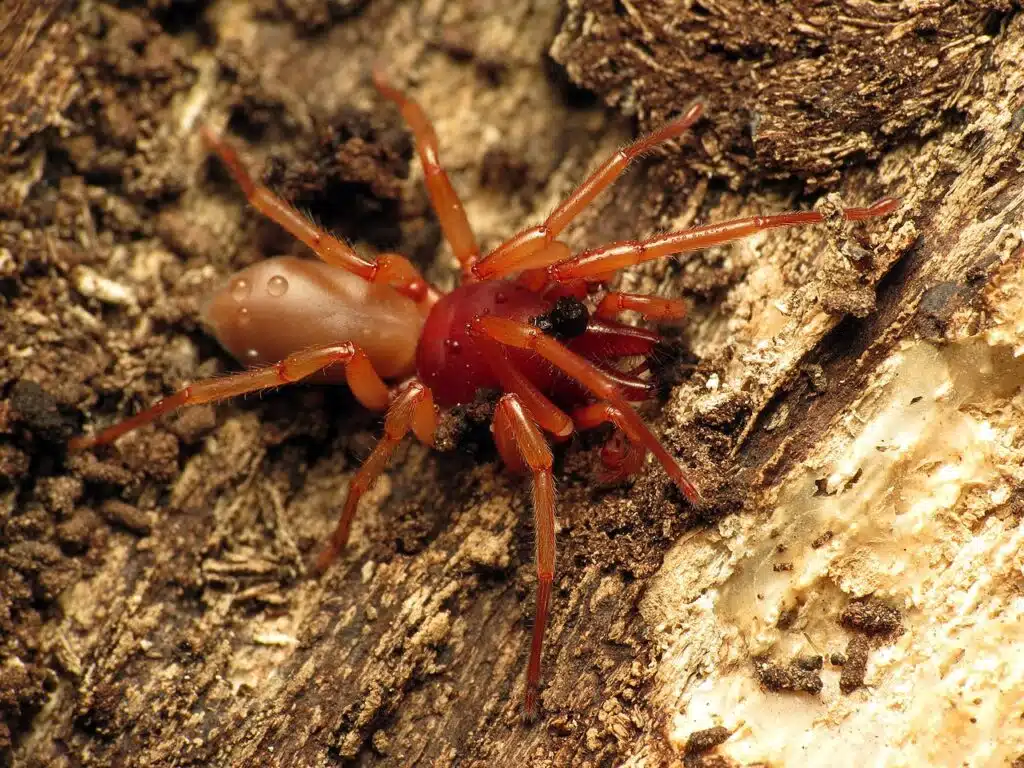
Scientific name: Dysdera crocata
Common name: Woodlouse spider, woodlouse hunter, sowbug hunter, sowbug killer, pillbug hunter and slater spider
Woodlouse spiders are some of the most common red spiders found in homes.
The species is dominated by a red or brown-red cephalothorax and a tan abdomen.
This spider has size differences between males and females. The female Woodlouse spider is larger, growing to a maximum size of 15mm while the male grows to a maximum size of 10mm.
The legs of the Woodlouse spider are also red or brown-red.
Woodlouse spiders are known for having very long mouthparts compared to the size of their body.
These large mouthparts allow the Woodlouse spider to be one of the most efficient predator species in the house where it can tackle roaches and other spiders.
2. Red House Spider
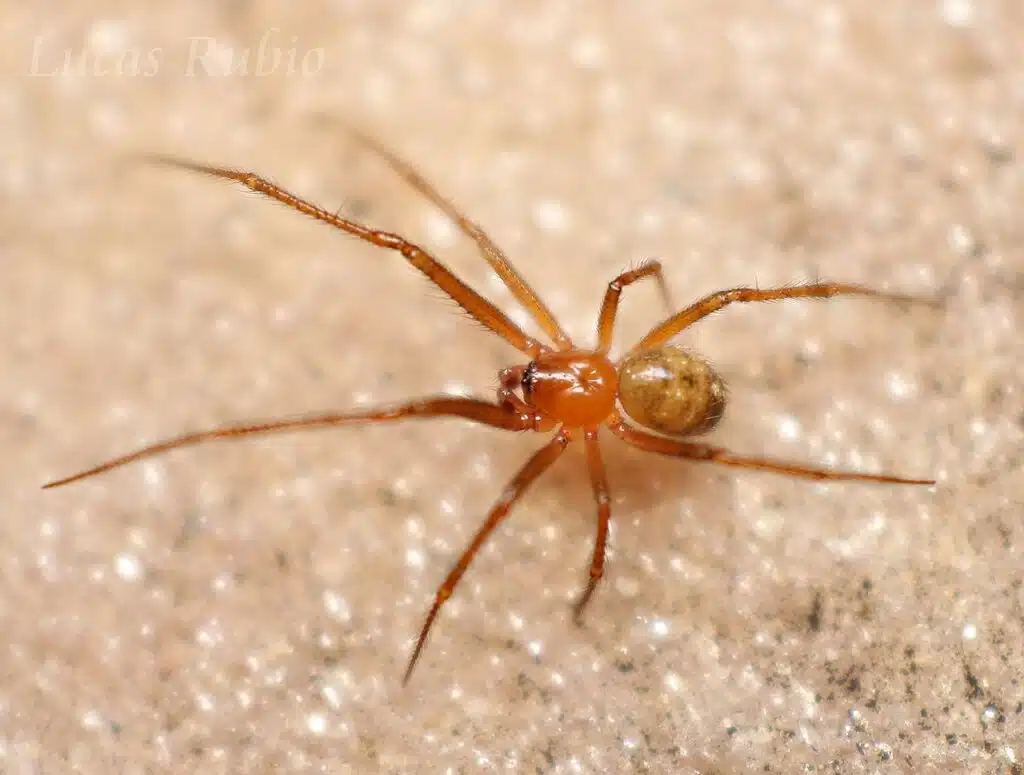
Scientific name: Nesticodes rufipes
Common name: Red house spider
The Red House spider is a venomous species known for its impact on homes. The pain of its sting is high and people often compare it to the sting of the Redback spider.
Red House spiders are a common venomous species characterized by a red to red-brown body color.
This spider has a bulbous abdomen and shiny dark red legs.
Common in warm habitats, the Red House spider is known for building spider webs.
It builds these spider webs in some of the most inaccessible parts of the house for humans which are known to attract insects.
Red House spiders commonly build spider webs behind furniture or in corners, preferably away from direct sunlight.
3. Broad-Faced Sac Spider
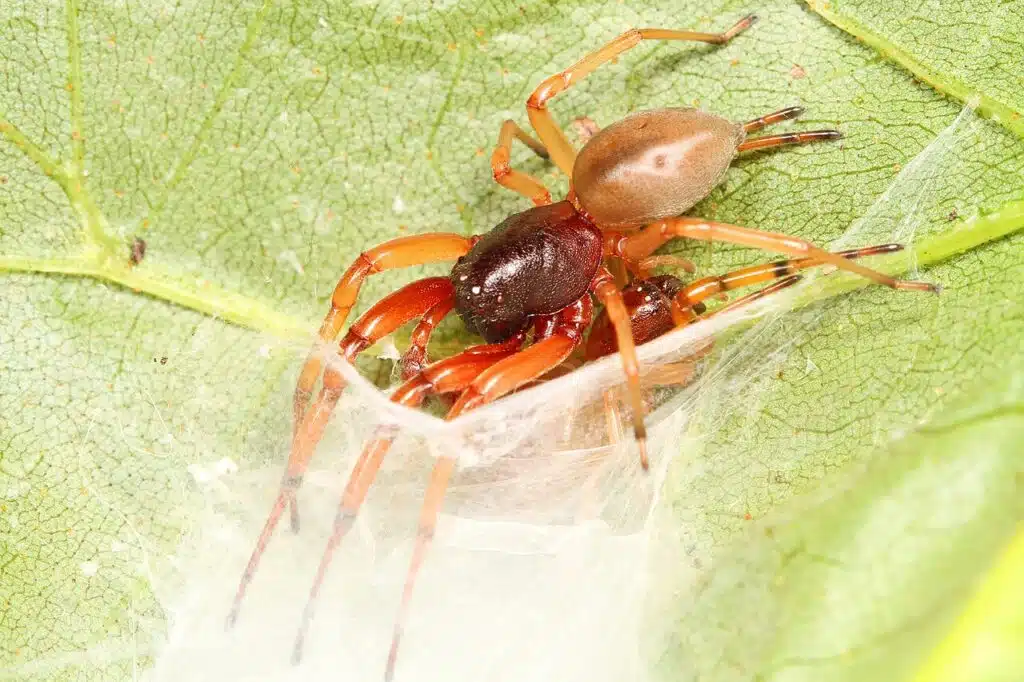
Scientific name: Trachelas tranquillus
Common name: Broad-faced sac spider
Like many red spiders seen around the house, the Broad-Faced Sac spider is known for exhibiting multiple colors.
The cephalothorax is dark red to brown while its legs are bright red.
A muted gray color is specific to the abdomen which has small holes in it that may appear as perforations upon close inspection.
The Broad-Faced Sac spider is smaller than other red spiders in the house such as the Woodlouse spider.
This species grows to a size of 5-6mm in the case of male spiders and up to 7-8mm in the case of females.
Female spiders of the genus are known to bite. It’s best not to touch these spiders as a result.
The bite is painful and dangerous. Apart from the pain itself, the bite of this spider might also cause infections that require medical attention.
4. Black-tailed Red Sheetweaver
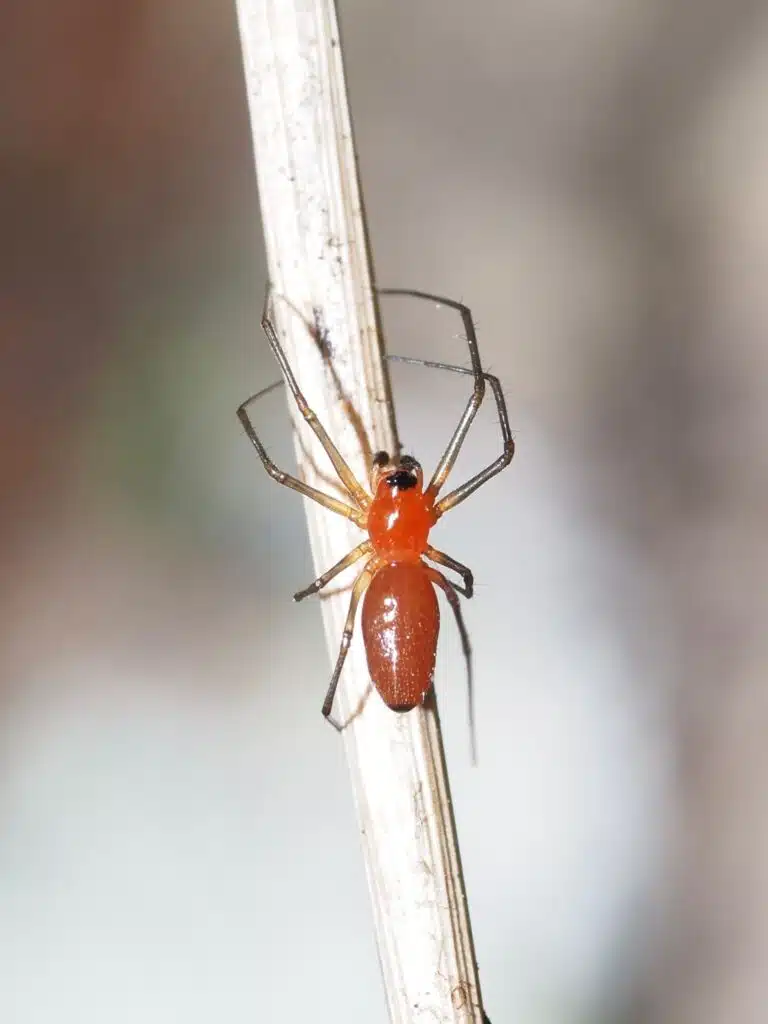
Scientific name: Florinda coccinea
Common name: Black-tailed red sheetweaver
The Black-tailed Red Sheetweaver is one of the smallest red spiders in homes. It reaches a maximum length between 3 and 4mm.
The species is known for its bright red coloring with a shiny outer layer both on the cephalothorax and on the abdomen.
This spider also has long thin black legs.
Black marks are sometimes visible on the head of the female.
The tip of the abdomen is also black in this species.
Some color variations are seen on Black-tailed Red Sheetweavers. Spiders of this genus can have a darker red cephalothorax compared to the light red abdomen at times.
5. Black-banded Crab Spider

Scientific name: Synema parvulum
Common name: Black-banded crab spider
The Black-banded Crab spider gets its name from its black rear strip. But this species has a red-brown abdomen and a light red cephalothorax.
Its front legs are dark red while the rear legs are light-colored.
Spiders of this genus are known for moving sideways similarly to crabs.
Black-banded Crab spiders eat invasive species in the garden such as aphids being considered a beneficial type of spider.
They easily move indoors from gardens.
6. Bull-headed Sac Spider
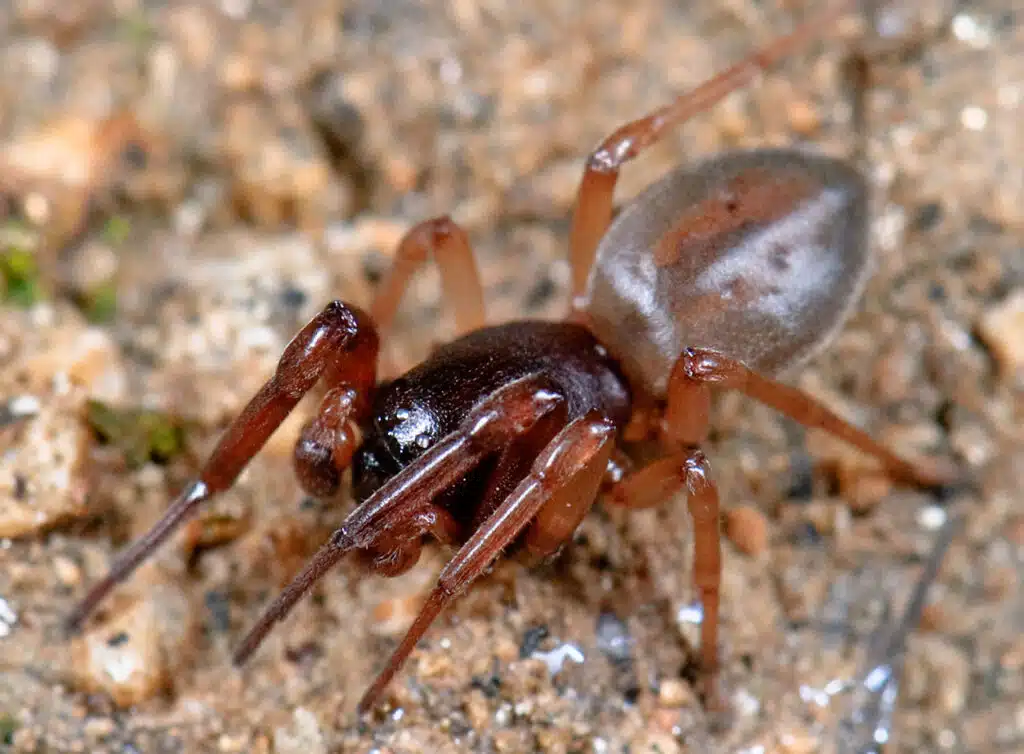
Scientific name: Trachelas pacificus
Common name: Bull-headed sac spider
Bull-headed Sac spiders are known to scavenge insects which can one of the reasons they can transmit infections.
Bull-headed Sac Spiders are common in homes and around homes. They have a red upper body and red legs while the abdomen is gray or olive-gray.
Spiders of this type grow to a size of 7-10mm in the case of females and up to 6mm in the case of males.
Venomous and common around the house, this spider is mostly tied to man-made buildings. They can nest in piles of wood and make their way indoors looking for the living or dead insects.
7. Comstock’s Wafer Trapdoor Spider
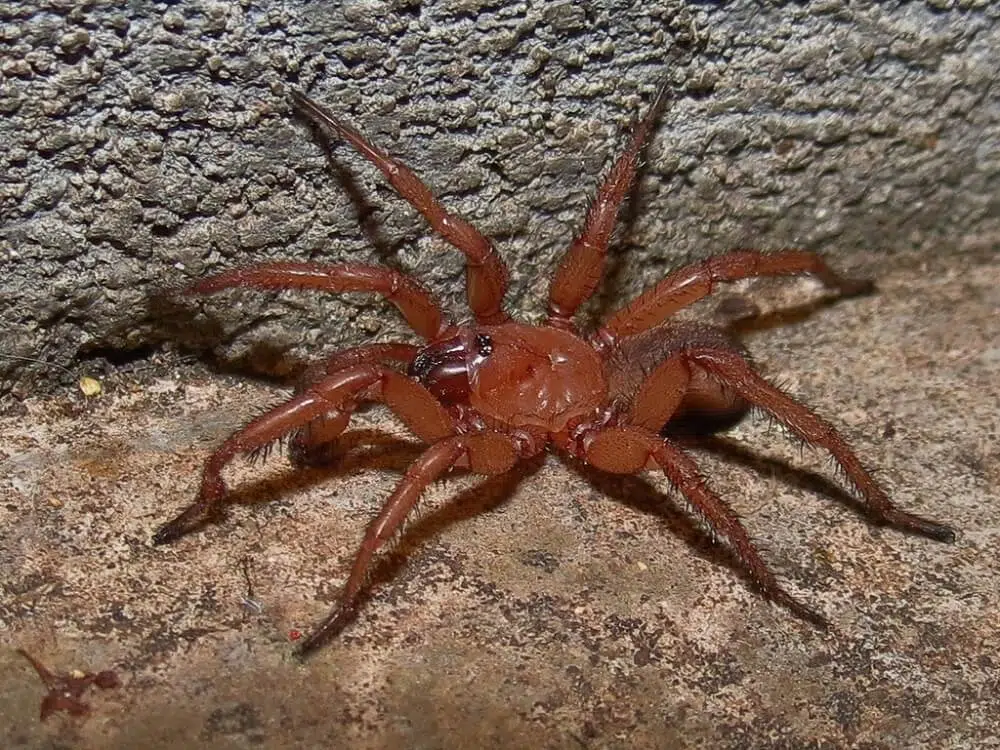
Scientific name: Myrmekiaphila comstocki
Common name: Comstock’s wafer trapdoor spider
Common in Southern US and Mexico, this is one of the mostly red species of spiders that can make it into homes.
The spider has a vivid red cephalothorax and a red hairy abdomen. It also has thick red legs with short black hair.
Only a small black mark on the top of its head resembles the black hairs on the legs.
Spiders of this genus are larger than others entering homes but they can climb and as a result, are often seen on walls with lights that attract insects they feed on.
8. Red Widow
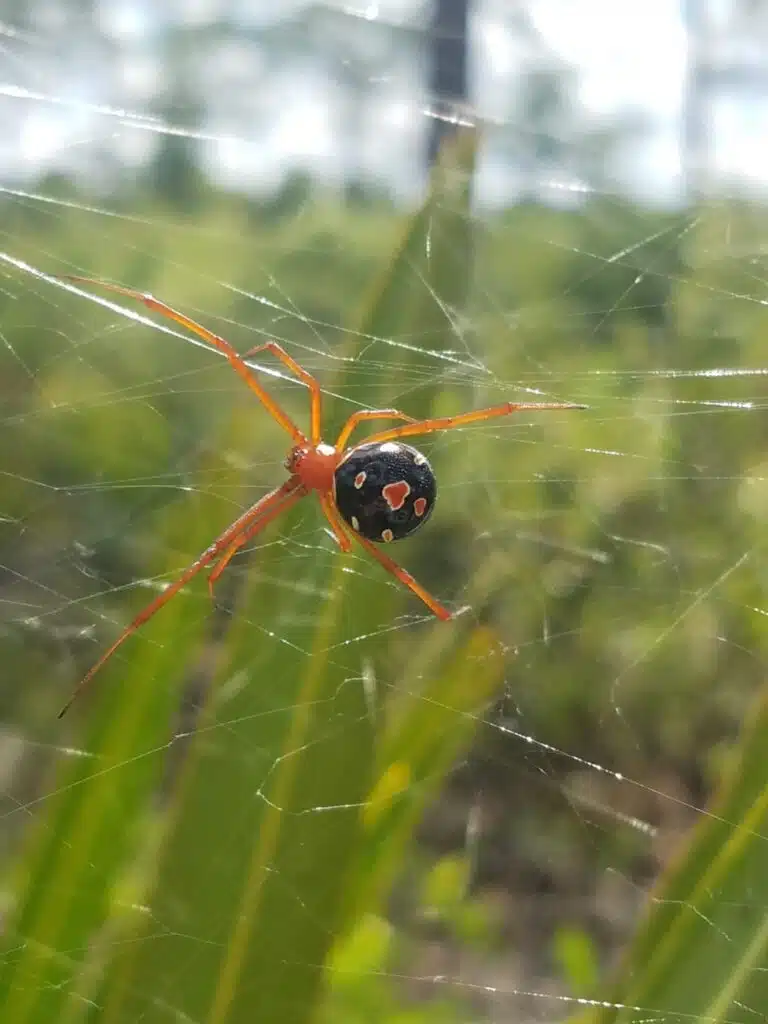
Scientific name: Latrodectus bishopi
Common name: Red widow
Sometimes confused with Black Widows, Red Widows are a common venomous spider species.
These spiders have red legs, a black abdomen, and a red mark or a mark with 2 red spots on the abdomen.
Red Widows lack the common red hourglass-like marking of Black Widows.
Mostly restricted to sandy areas of Florida, Red Widows don’t like to engage with humans. The venomous bite is dangerous but rare.
Most Red Widows are seen outside habituated areas or in parks, gardens, or front yards decorated with palmetto bushes.
Red Widows should not be handled as they can bite if squeezed.
9. Silvestri’s Cave Spider
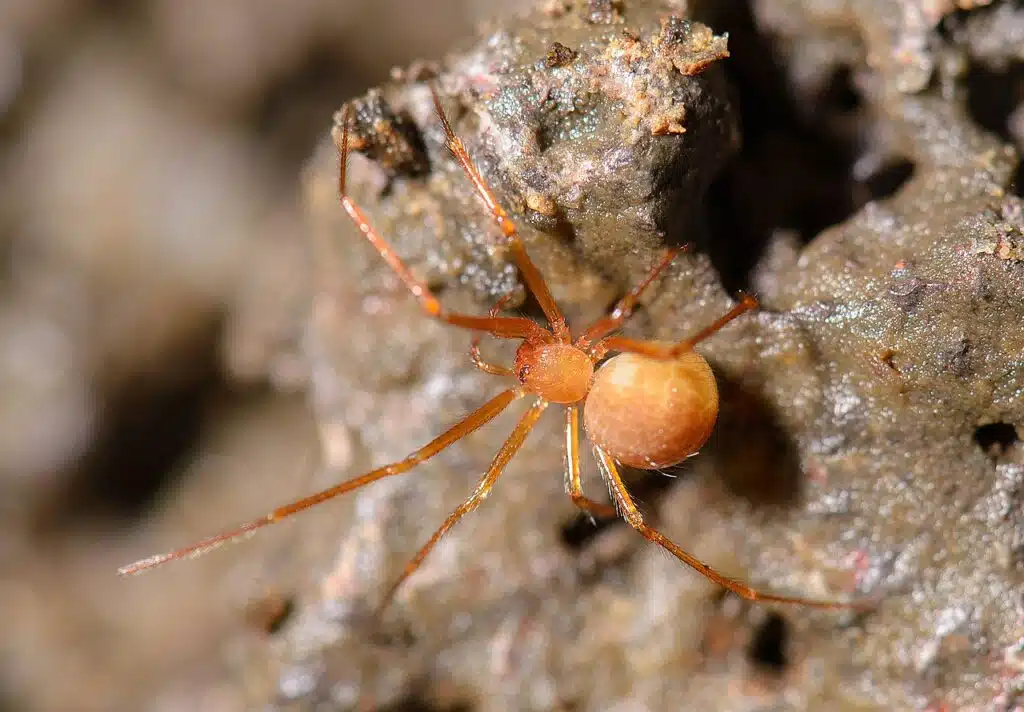
Scientific name: Nesticus silvestrii
Common name: Silvestri’s cave spider
Silvestri’s Cave spider is common in Northern parts of the US. This spider has a red or brown-red color specific to its habitat.
The darker its color the likelier the spider lives in caves. Bright red Silvestri’s Cave Spider morphs are common on crops as well as in gardens and homes.
This group of spiders also come in other morphs such as light brown and tan. All of them have a uniform color in common.
10. Prairie Ant-mimic Sac Spider
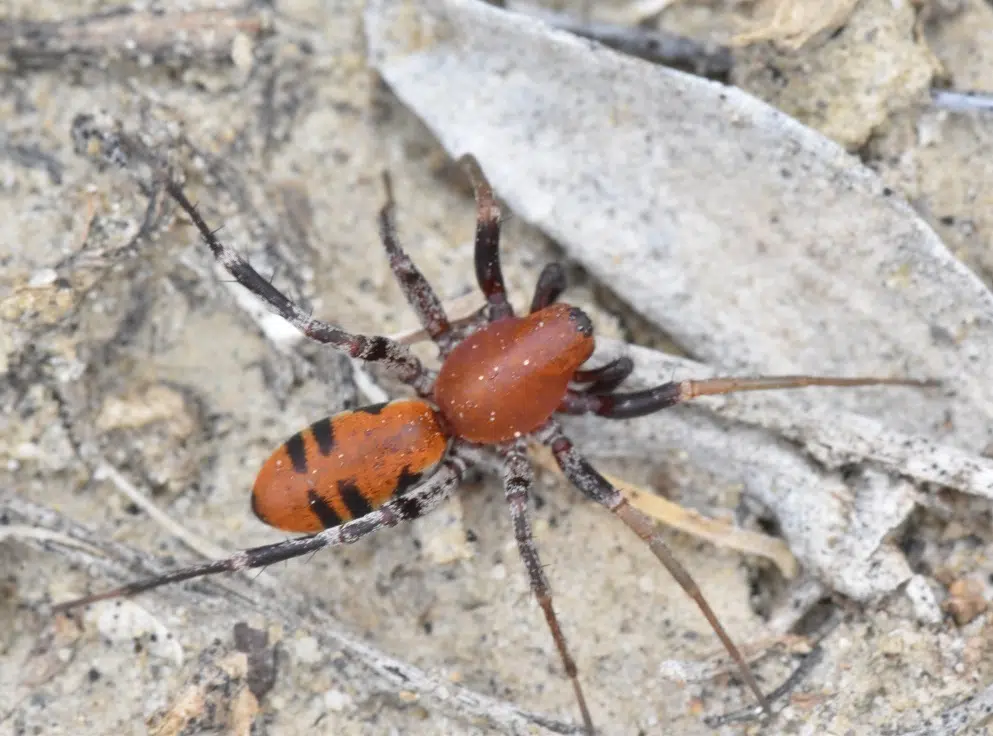
Scientific name: Castianeira alteranda
Common name: Prairie ant-mimic sac spider
Prairie Anti-mimic Sac spiders are a genus that resembles ants and that come in various colors.
Most morphs of this spider genus have a combination of either red and black or brown and black coloring.
The top part of the cephalothorax and the abdomen are red with lateral black bands across the body.
This ant-mimicry allows these spiders to get closer to some ant nests as they commonly feed on ants.
Some Prairie Ant-mimic Sac spiders also come in black and white colors.
11. Big-eyed Thick-jawed Spider
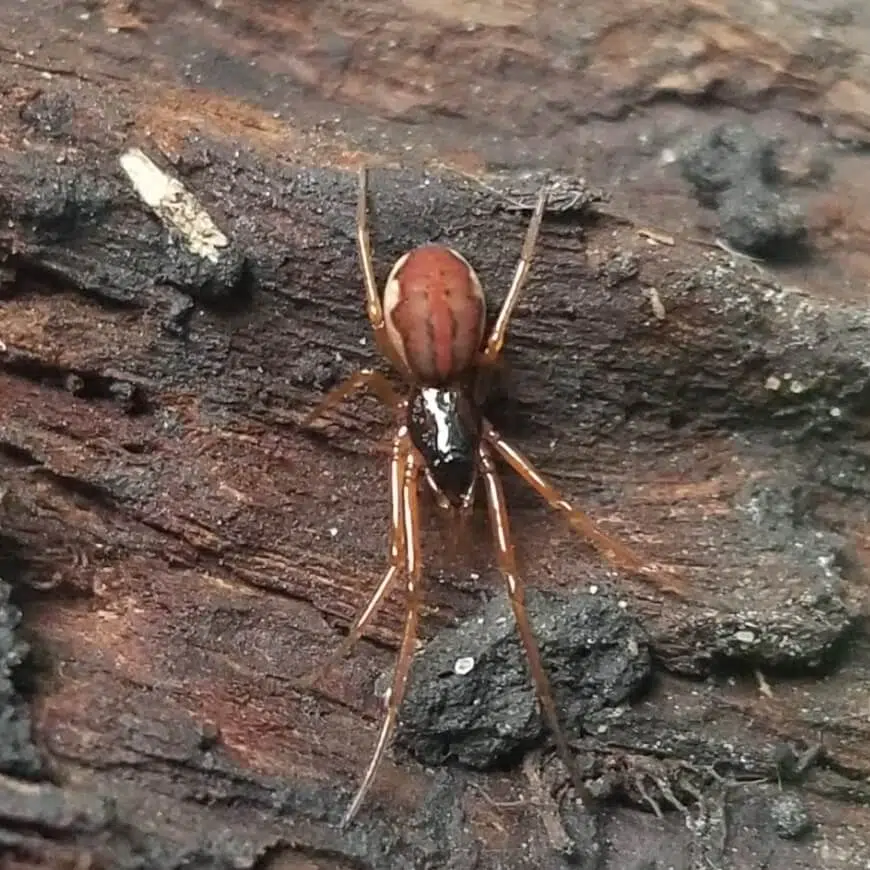
Scientific name: Pachygnatha autumnalis
Common name: Big-eyed thick-jawed spider
Big-eyed Tick-jawed spiders come in multiple colors. A red morph is common in this species.
The red variant has a dark red cephalothorax and a light red abdomen.
These morphs also have light red legs.
Orange or red-brown marks are common on the abdomen of the species.
Spiders of this genus may also show white stripes on the sides of the abdomen.
An orange or red line along the central section of the abdomen is also common.
While barely visible due to the reduced size of the species, the red stripe on the abdomen is what makes it also resemble Red Widows.
12. Openfield Orbweaver
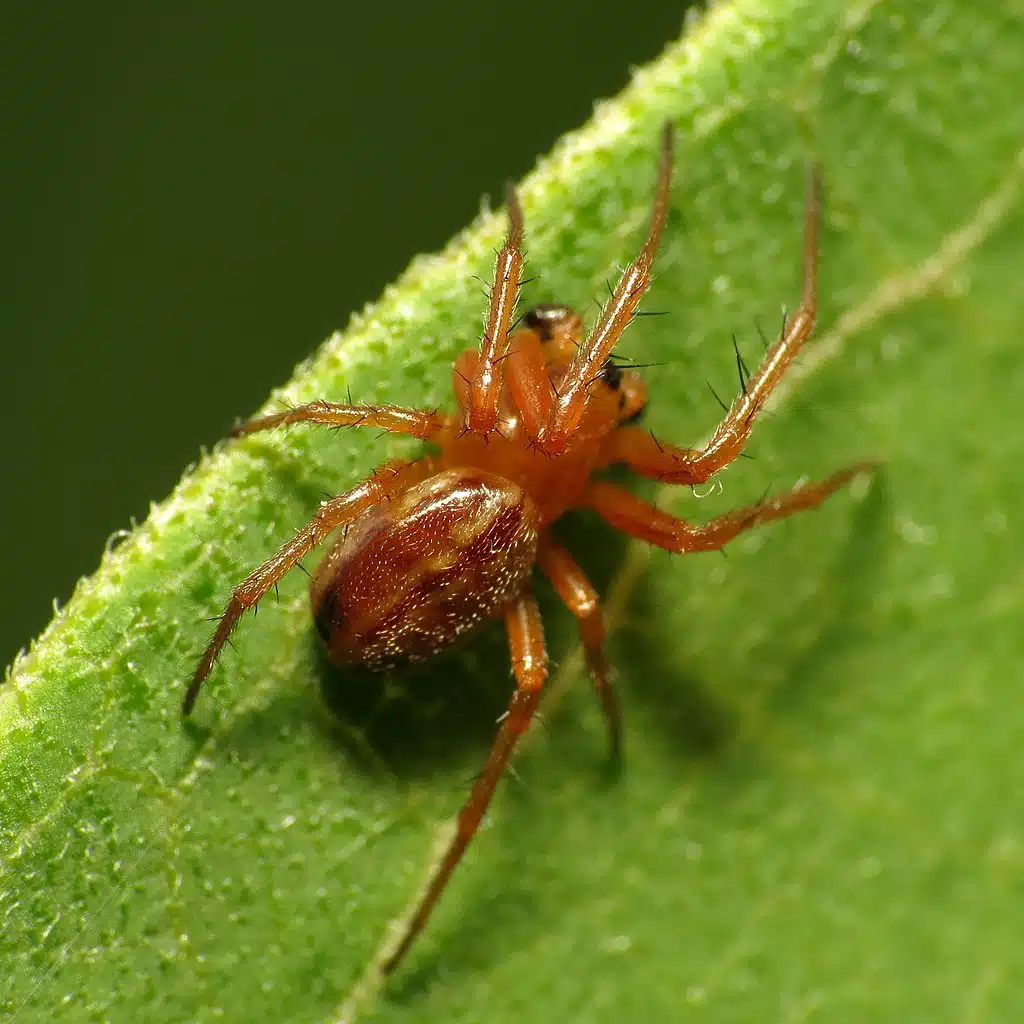
Scientific name: Araneus pratensis
Common name: Openfield orbweaver
Part of the Araneae family, the Openfield orb weaver spider is found in the US and Southern Canada.
This species has a red abdomen with white vertical stripes and a pale red cephalothorax. The legs of the spider are also red.
A round dome-shaped abdomen is characteristic of the species. Its white stripes help it distinguish itself from other orbweavers.
Common around homes, these spiders easily move indoors for food. It’s the female that makes it indoors most of the time as smaller males are rarely seen.
13. Walckenaer’s Studded Triangular Spider
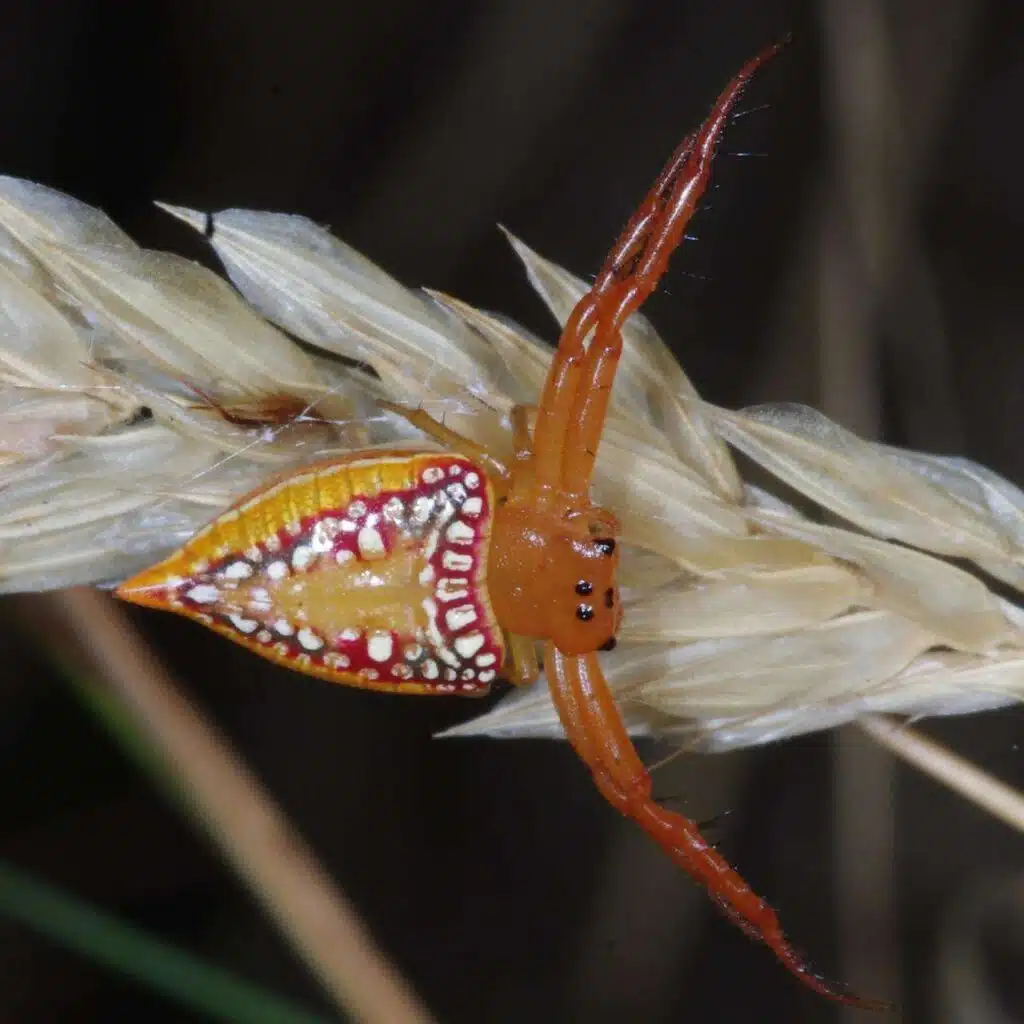
Scientific name: Arkys walckenaeri
Common name: Walckenaer’s studded triangular spider, walckenaer’s studded arkys
The triangular-shaped species of spider is known for its mostly red coloring. Spiders of this genus have a red cephalothorax and red legs.
The abdomen of the species has a triangular shape. It has red, white, blue, and yellow coloring.
Black bristle-like hairs are seen on the front legs of the species.
Some Walckenaer’s Studded Triangular spiders have different color rear legs. These spiders can have red legs or green rear legs.
The color pattern on the abdomen is irregular but it stands out as white is the dominant color in this section.
14. Small Thief Spider
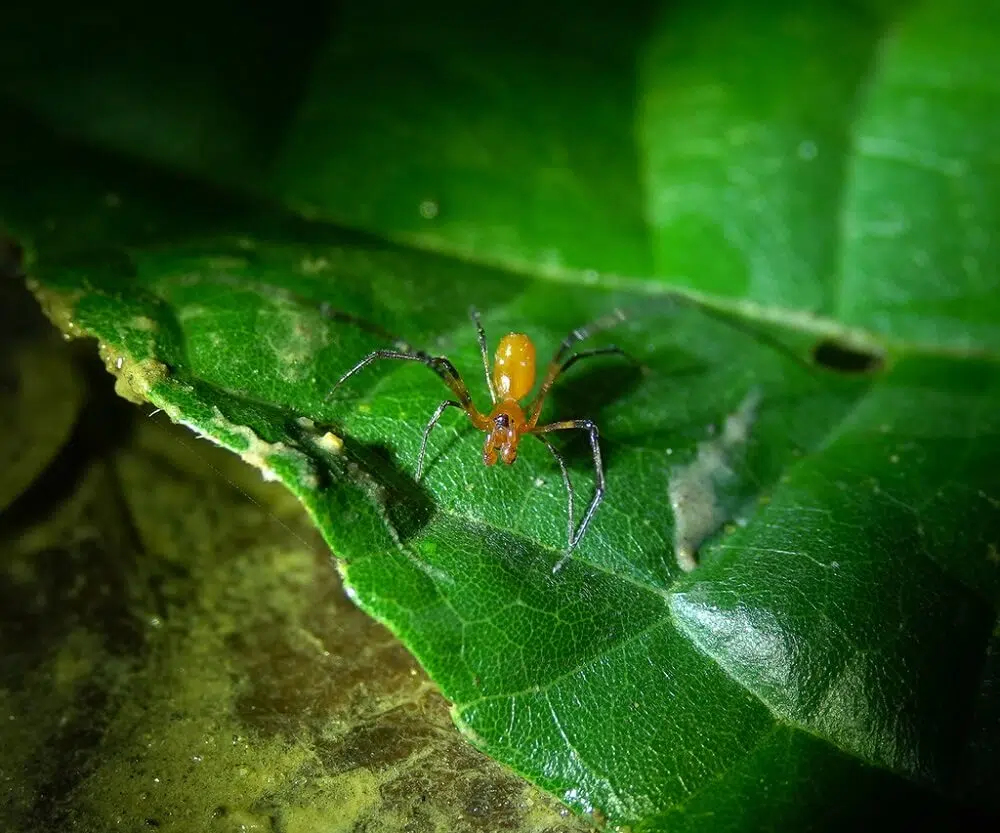
Scientific name: Argyrodes miniaceus
Common name: Small thief spider
This species grows up to a size of 4.5mm being one of the smaller red spiders in the US.
It features distinct red coloring with white marks on the abdomen. Its cephalothorax is also red but considerably smaller.
The long thin legs of the species are black.
Most people know Small Thief Spiders are a parasite species.
They find a suitable spider web of other spiders, typically orb weavers, to live on.
These small spiders then steal any insects that get caught up in the spider web of the host spider.
Such small parasitic spiders are often tolerated by the host species due to their vivid coloring and their movements on the spider web.
These movements can attract flies into the spider web of the host species.
15. Shamrock Orbweaver
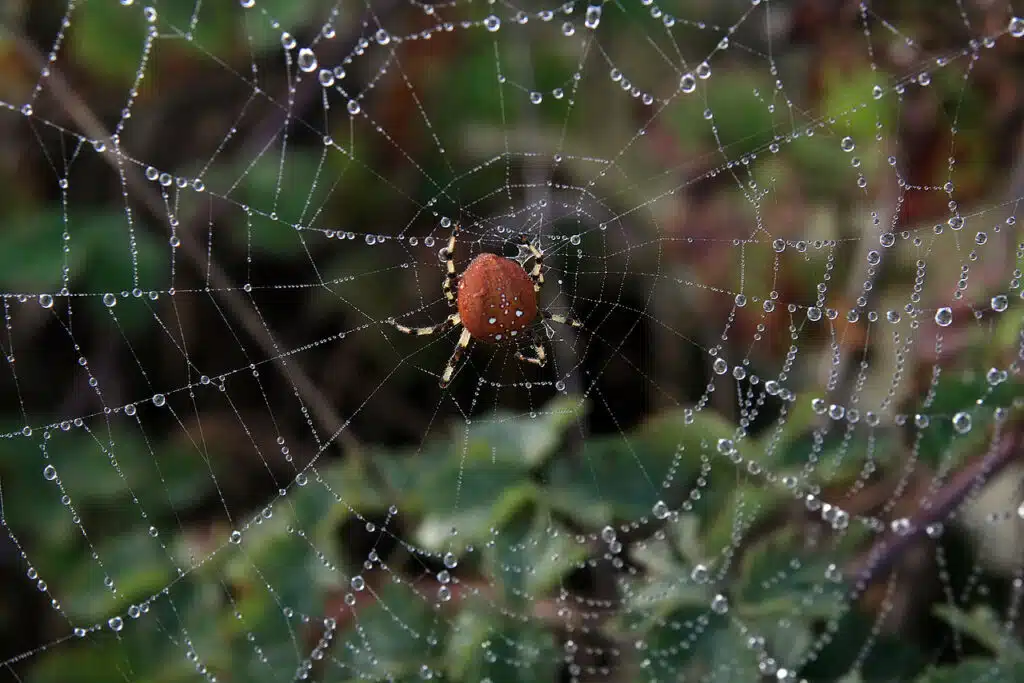
Scientific name: Araneus trifolium
Common name: Shamrock orbweaver
Common on US grassland, the Shamrock Orbweaver is one of the species red specie that builds spider webs.
These red spiders have a wide red abdomen with white or red spots. They have white and black striped legs and are known for building vertical spider webs.
These small spider webs are common in the grass or other types of vegetation.
This species is always connected to the spider web through a single silk line and hang just above the ground waiting for prey to get trapped.
Shamrock Orbweavers live up to a year and are common in gardens alongside grassland and prairies.
They can bite people at times, especially when roughly handled. The mild venom of the species is only dangerous to small insects as it doesn’t affect people.
16. Rubens Orbweaver
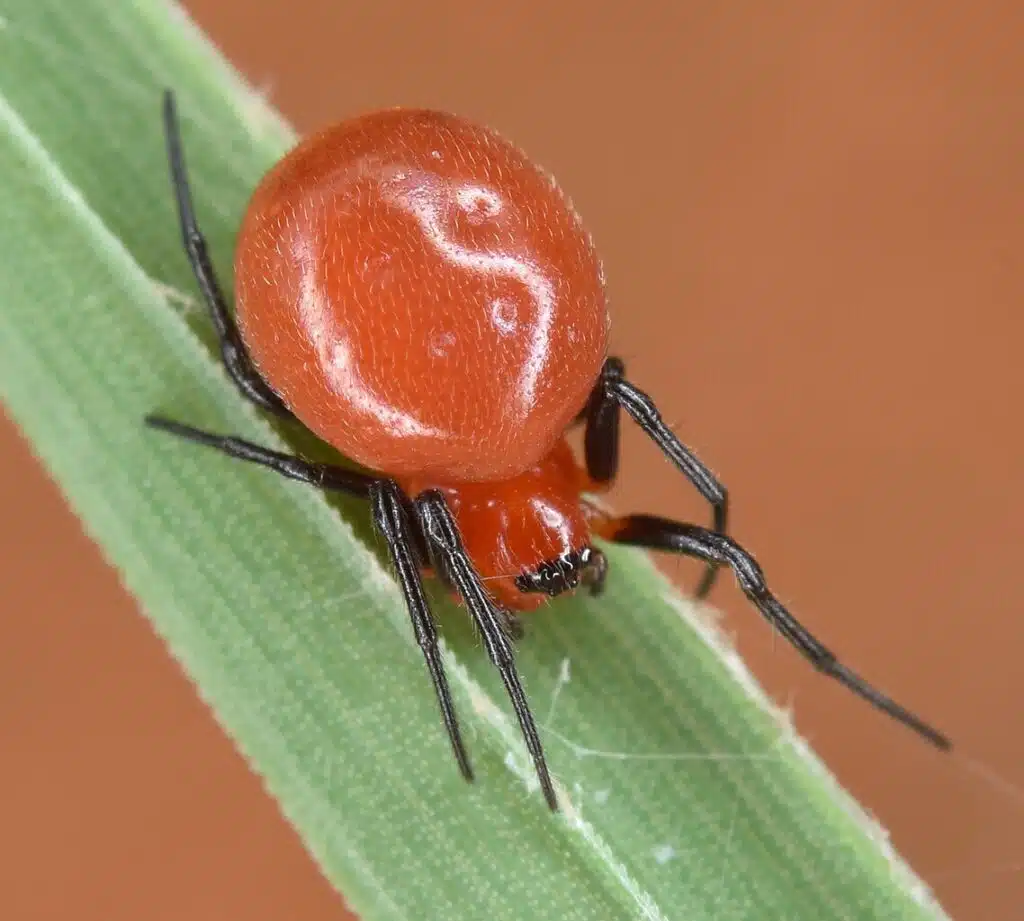
Scientific name: Hypsosinga rubens
Common name: Rubens orbweaver
This spider species is also seen in different colors. Its red uniform color is a common sight, especially with black legs.
The spider also comes in a red-brown color alongside a tan morph.
In some habits, this spider has a red body and red legs. This morph comes with a dark brown head and a dark rear abdomen.
Rubens Orbeweavers are influenced by their habitat when it comes to coloring. The gender of the spider is also important as male spiders are more likely to have a uniform red color.
Spiders of this genus are smaller than the average red spider in the US. Males grow to a maximums size of 3.5mm.
17. Red-bellied Jumping Spider
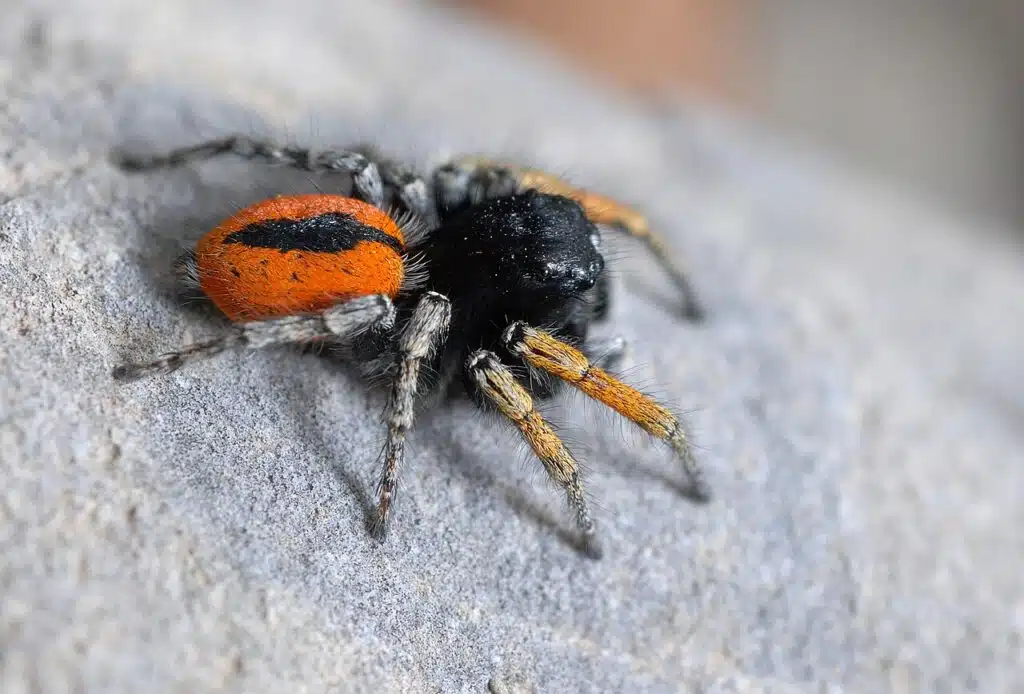
Scientific name: Philaeus chrysops
Common name: Red-bellied jumping spider
The Red-bellied Jumping spider gets its name from the coloring of its underbelly. This spider is known for being black on top.
An orange-red abdomen is characteristic as are red front legs.
The spider has a variable size as it grows from 7 to 12 mm in the case of females. Males are almost twice as small with an average size of 5mm.
The front red legs of the species are best seen in the mating process.
The female Red-bellied Jumping spider taps the ground with the red front legs in the courtship process.
Females use this gesture to approve of a potential male mate.
Spiders of this genus are found on rocky terrains.
18. Johnson’s Jumping Spider
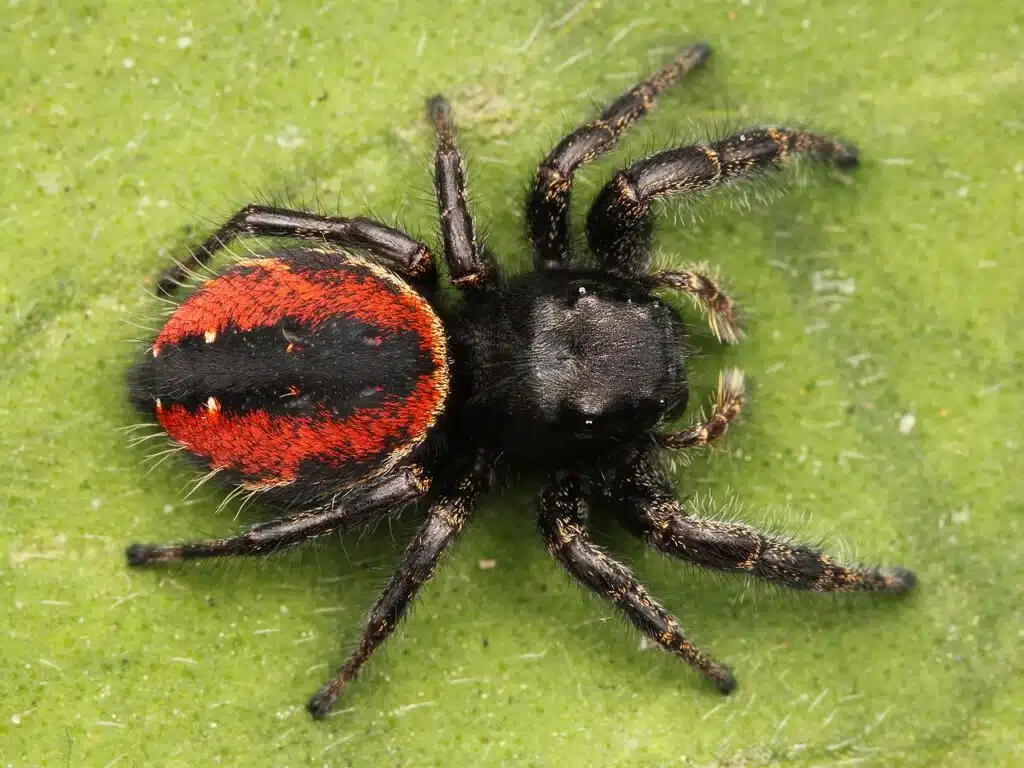
Scientific name: Phidippus johnsoni
Common name: Johnson’s jumping spider, red-backed jumping spider
Johnson’s Jumping spider is a red and black species. Its abdomen is red while the rest of the body and the legs are black.
Spiders of this genus have small coloring differences between the sexes.
Females have a central black stripe on the red abdomen. Males have a mostly uniform red abdomen.
Johnson’s Jumping spiders are a species that mimics red multillid wasps in their color.
These spiders also resemble other species known for red and black coloring which might even be venomous.
Johnson’s Jumping spiders are sometimes confused with the similarly colored Redback spider.
These red spiders can be found in various habitats from low altitudes to high altitudes during the day.
19. Whitman’s Jumping Spider
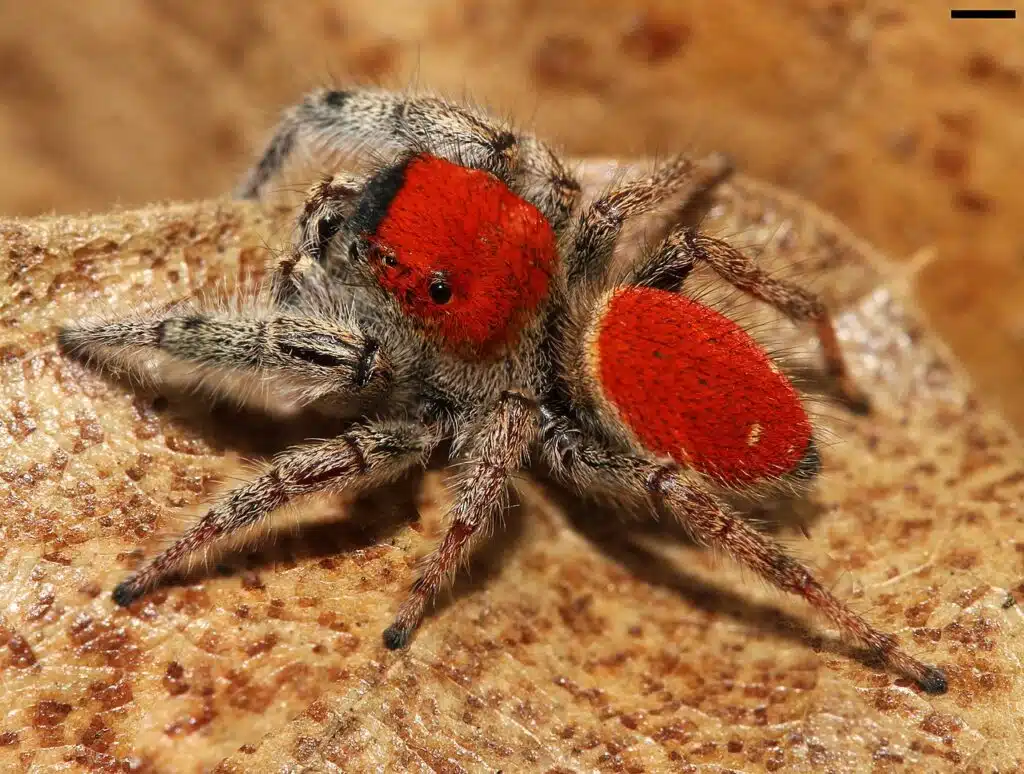
Scientific name: Phidippus whitmani
Common name: Whitman’s jumping spider
This spider species is known for its bright red coloring inside wasps.
It has a red cephalothorax and a red abdomen. The forelegs are sometimes red as well.
However, it’s only the male Whitman’s Jumping Spider that’s red as the female is mostly brown or brown-gray.
Found in the Eastern United States, Whiteman’s Jumping spiders prefer mixed forests.
Spiders of this family grow to an average size of 0.42 inches and they can be seen directly jumping on prey instead of building spider webs.
While not venomous, Whitman’s Jumping spider can bite and its mild venom can be painful and even lead to skin redness and rashes.
Spiders of this genus live longer than others in mixed hardwood forests as they can survive up to 2 years.
20. Apache Jumping Spider
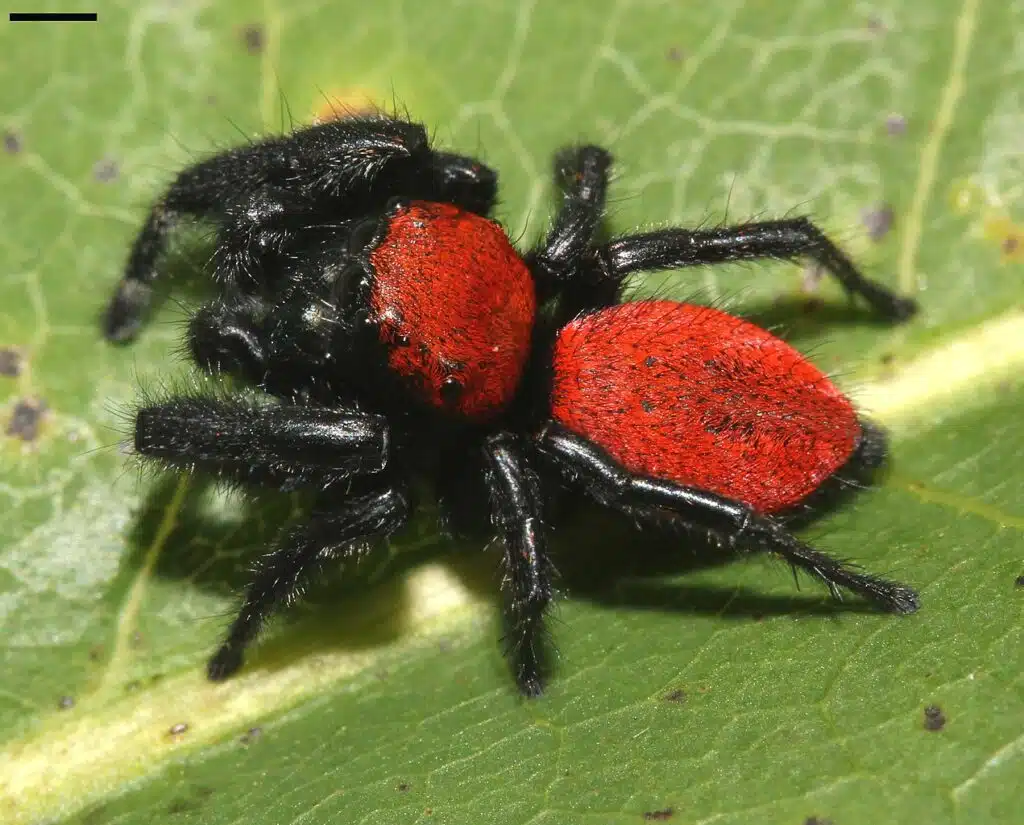
Scientific name: Phidippus apacheanus
Common name: Apache jumping spider
Apache Jumping spiders come with a red or yellow dorsal color. This bright color dominates the male and the female spiders, both with a black underside.
The female Apache Jumping spider has a black central line on the abdomen.
There’s a wide range of sizes this spider is seen depending on its habitat, age, food availability, and gender.
A small male can measure only 3mm while a large female can measure up to 22mm.
These colorful spiders prefer deserts and dry grasslands.
It’s here that it can be seen hiding around bushes or cacti. Apache Jumping spiders live both in low and high elevations.
21. Cardinal Jumping Spider
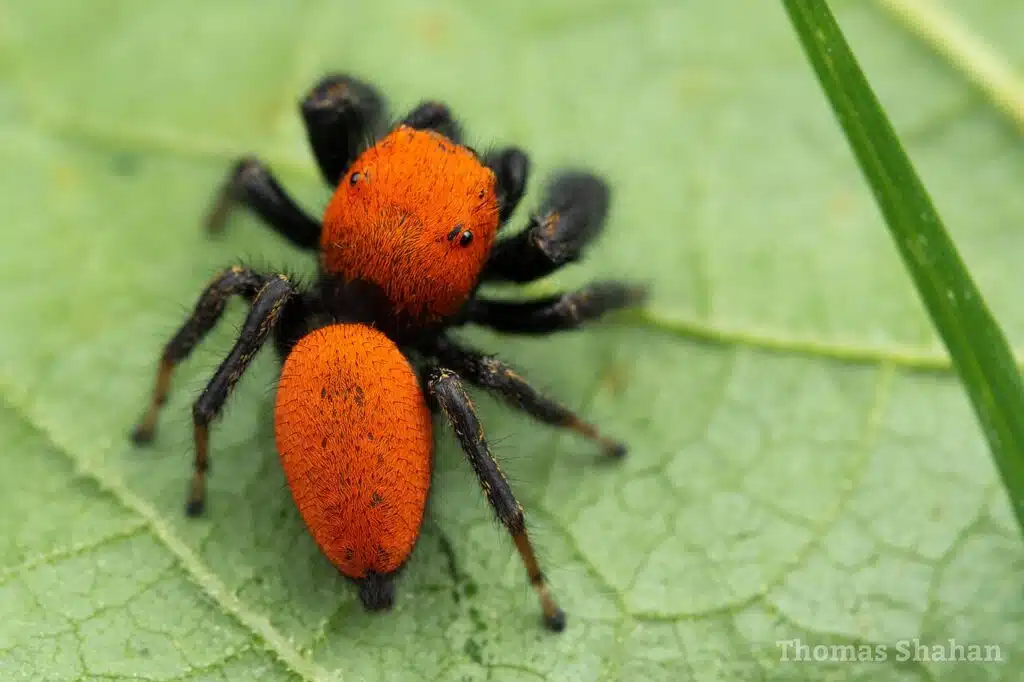
Scientific name: Phidippus cardinalis
Common name: Cardinal jumping spider
The Cardinal Jumping spider is a species of spider that mimics multiliid wasps.
Spiders of this group have a red color in the case of males and an orange-red color in the case of females.
Male spiders have a black underside while females have a brown underside.
Spiders of this genus do not spin webs and they use agility to jump on prey.
Smaller male Cardinal Jumping spiders are also seen as prey by multiple other species which include birds.
Common in North America, these spiders eat various small flies and crickets.
22. Red Weaver Ant-mimicking Spider
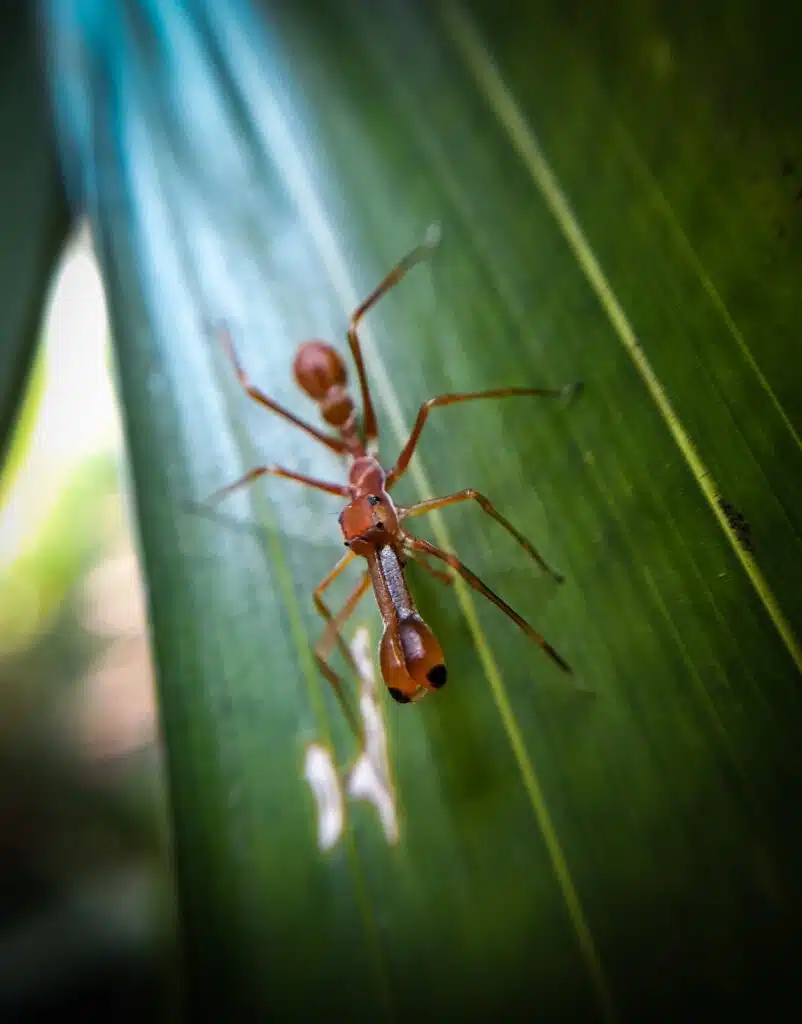
Scientific name: Myrmaplata plataleoides
Common name: Red weaver ant-mimicking spider
The Red Weaver Ant-mimicking spider is known for its high resemblance to the Asian Weaver ant.
Spiders of this genus have the same color and the same shape as the Asian Weaver ants which doesn’t make them appear as spiders at all.
This mimicry allows Red Weaver Ant-mimicking spiders to stay in colonies next to the ants themselves.
In turn, this helps protect them from predators. Many predators such as birds know that Asian Weaver ants have a bad taste.
Spiders of this genus might mimic ants but they still create spider webs.
They build spider webs on top of ground-level leaves as shelter and to hide. Spiders come out to pounce on prey given the opportunity.
Spiders of this genus use temperamental ant mimicry as well. Males can fight each other using long fangs and the spiders are known for even moving like ants.
These spiders can jump, unlike Asian Weaver ants. However, they only resort to jumping on rare occasions.
23. Slender Ant-mimic Jumping Spider
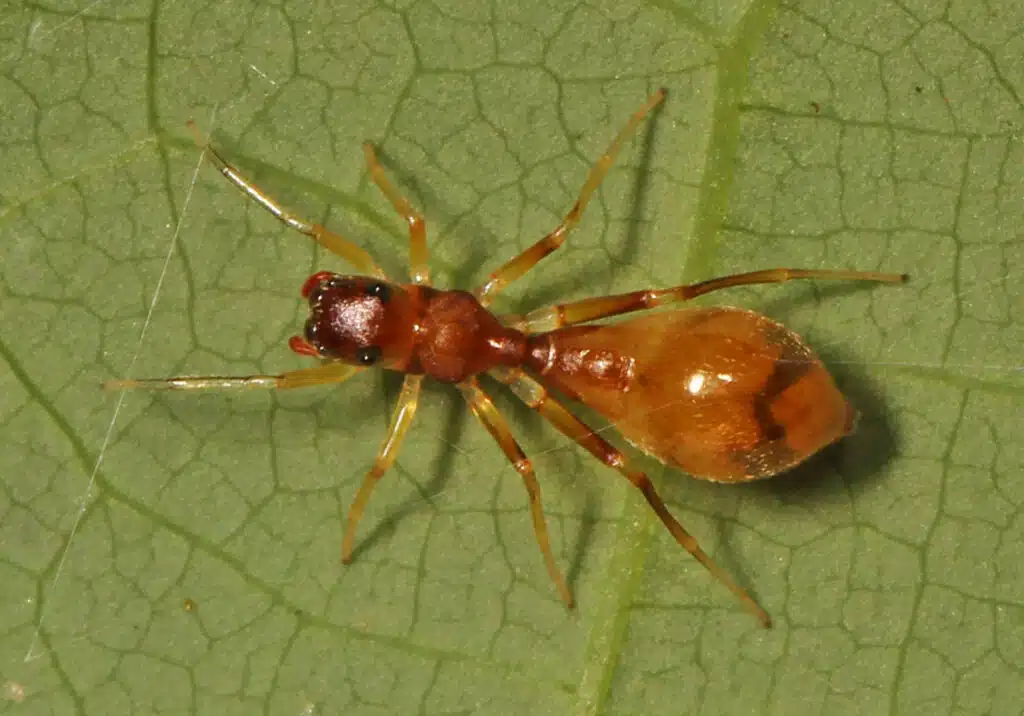
Scientific name: Synemosyna formica
Common name: Slender ant-mimic jumping spider
This small spider mimics ants in coloring and shape. It has a dark red color and a thin elongated body similar to ants.
Its reduced size and the fact it resembles ants make it deter some predators away.
This species moves like ants but it can move like spiders as well. Its legs are long and slender, similar to the legs of ants.
Its front legs are used to mimic ant antennae.
The positioning of the eyes makes for easier identification as spiders. There are 3 rows of eyes this spider uses to move around.
Spiders of this genus cannot build spider webs. They can jump on prey in ambushing movements.
However, these spiders prefer to ambush prey by crawling up to it as jumping might give away their true nature.
24. Long-horned Orbweaver
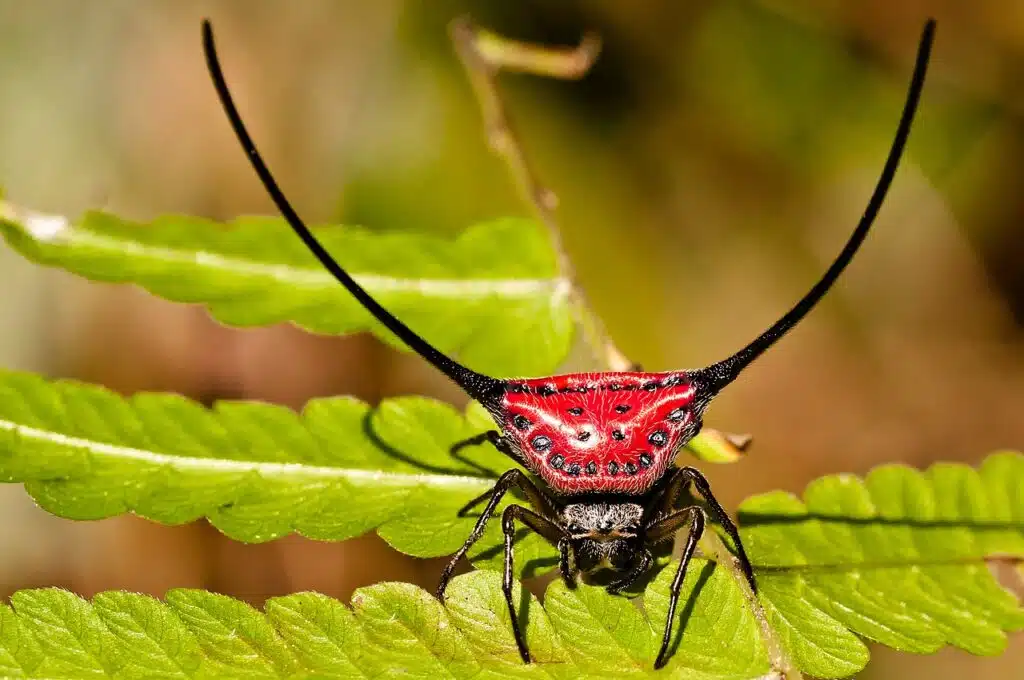
Scientific name: Macracantha arcuata
Common name: Long-horned orbweaver
Known for its long curved spines from the abdomen, the Long-horned Orbweaver is a common red spider.
This species is also known for its triangular abdomen shape. Its dorsal color is red and its ventral color is either yellow or black.
Known for its dark red coloring, the specie also shows particular traits such as small black dots on the abdomen.
These black dots follow the abdominal margins with 4 extra central dots distinguished on the abdomen as well.
Spiders of this genus have varying sizes and the females are larger growing up to 9mm.
Males are a few times smaller measuring around 1.5mm.
Further differences are also seen between the sexes as the male might not have a red abdomen but a black abdomen.
25. Ant-Like Crab Spider
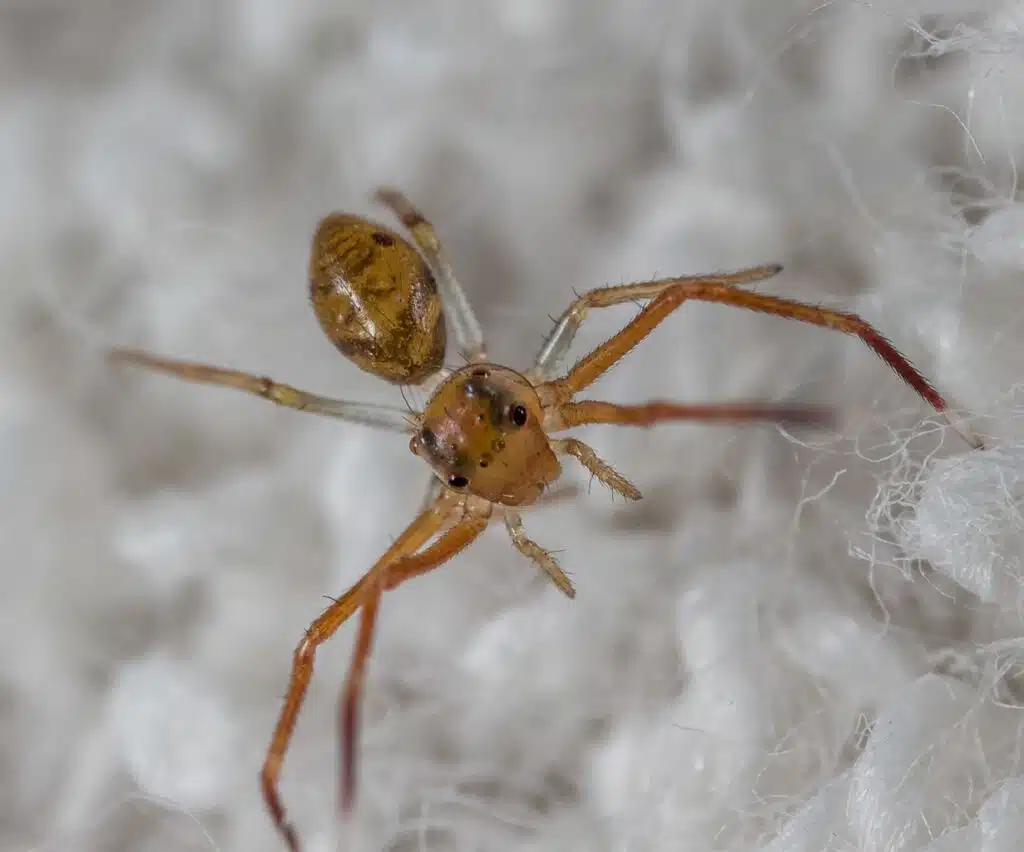
Scientific name: Amyciaea forticeps
Common name: Ant-like crab spider
Known as a mimicking spider, the Ant-Like Crab spider is one of the red spiders that resemble ants.
These spiders are also seen in tan and brown morphs.
Ant-like Crab spiders mimic ants to the extent they raise their front legs to make them resemble antennae.
This species is further identified by 2 large black spots on the lower abdomen.
These spiders have long slender legs they use to move slowly similar to ants.
Most Ant-like Crab spiders are a common sight on farmland where many ants live as well. This is where they have access to sugary foods such as fruits.
Ant-like Crab spiders blend in with the ants so that they aren’t predated. These spiders don’t eat fruit like ants, they prey on small insects.
26. Fighting Spider
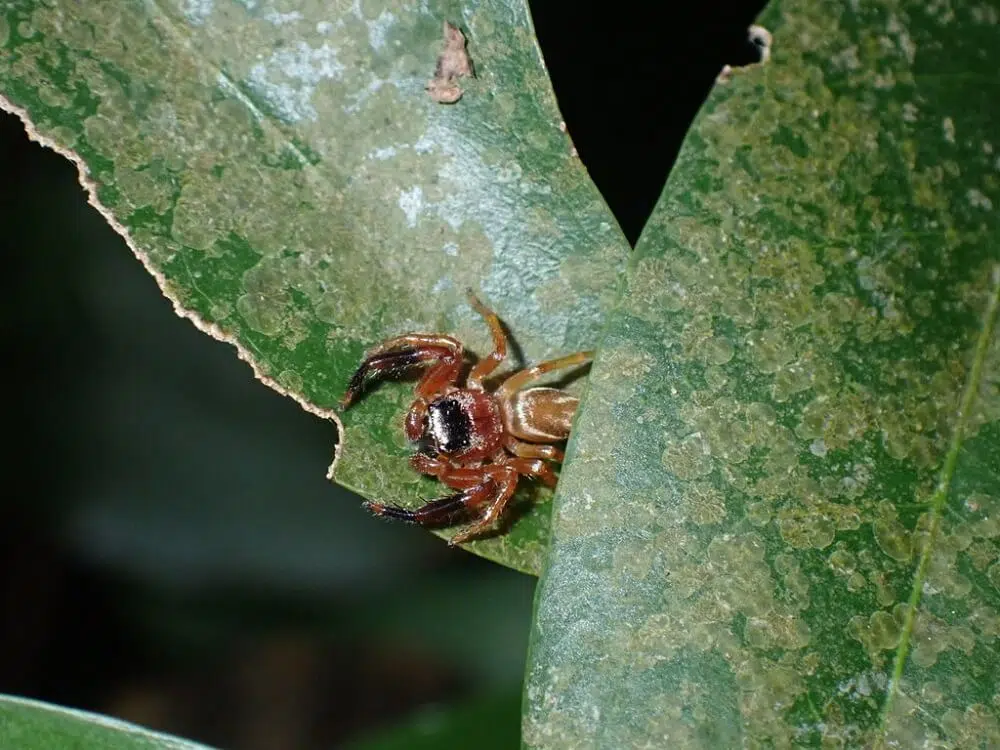
Scientific name: Thiania suboppressa
Common name: Fighting spider
Fighting spiders are known for the vivid colors they come in. The red morph has orange undertones making it one of the jumping spiders easy to spot.
Its color isn’t uniform, however.
The cephalothorax has dark red coloring and a brown mark on the head.
The lighter red coloring is specific to the abdomen. These spiders also have the same color differences on the legs.
The first 4 legs are dark red while the rear legs are light red.
Similar color shade nuances are characteristic of other morphs of the Fighting spider.
This species is further known for its capacity to jump a few times its body length.
27. Common Triangular Spider
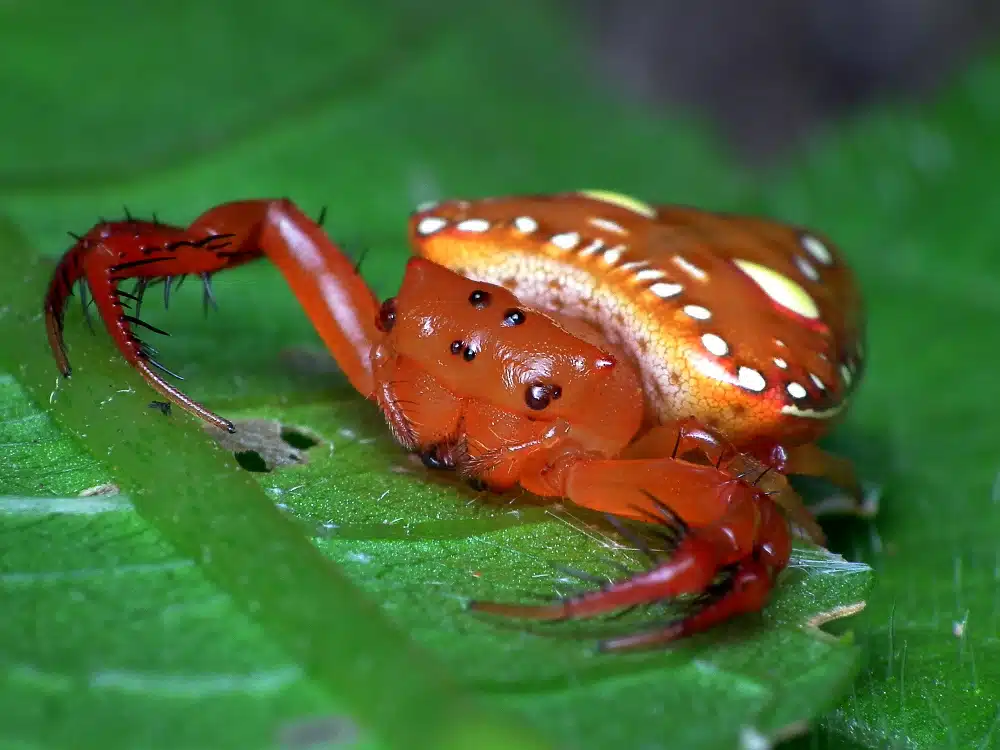
Scientific name: Arkys lancearius
Common name: Common triangular spider
Common Triangular spiders get their name from their triangle-shaped or heart-shaped abdomen.
These spiders have a wide abdomen with a pointed rear similar to the tip of an arrow.
The coloring on the Common Triangular spider is mostly red with orange tones towards the abdomen.
White marks with black borders are also visible on the body of this species.
The non-venomous Common Triangular spider has pale yellow rear legs and red front legs.
Spiders of this genus don’t build spider webs. They are nocturnal and can sometimes be seen during the day when they catch insects with their long front legs.
28. Red Tent Spider
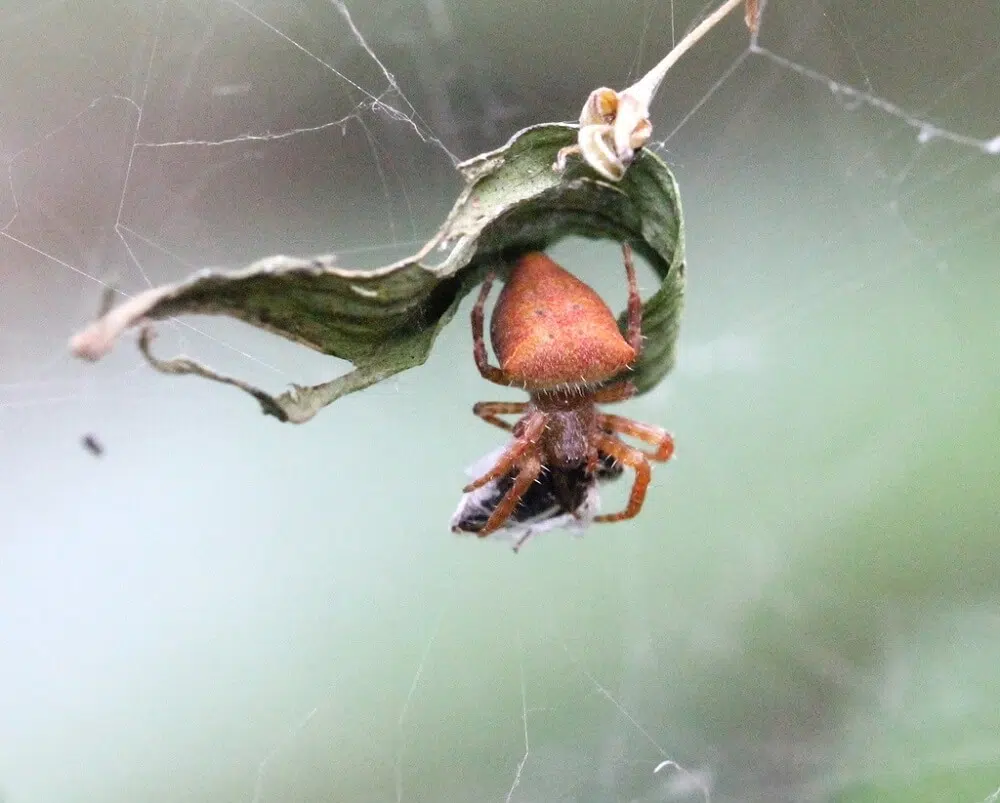
Scientific name: Cyrtophora unicolor
Common name: Red tent spider
The Red Tent spider is known for its bright red and dark red color morphs. Spiders of the genus have red legs and a yellow and red abdomen.
Male Red Tent spiders have an almost uniform red body but are darker compared to females.
Apart from the vivid coloring, the Red Tent spider is also known for its irregular-shaped spider webs.
Almost multi-dimensional, these spider webs are efficient at catching insects.
The female Red Tent spider sits in the center of the spider web. The female then moves to either side of the spider web quickly whenever insects get caught in it.
29. Spotted Cobweaver
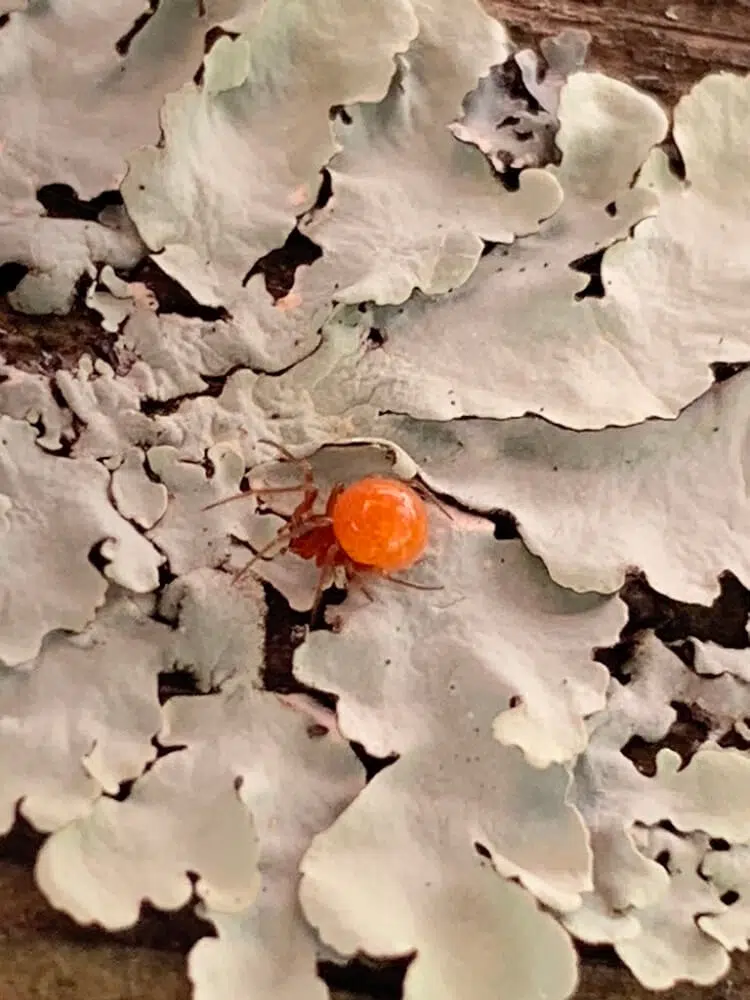
Scientific name: Thymoites unimaculatus
Common name: Spotted cobweaver
Spotted Cobweavers are a common sight in North America. These spiders are part of the Theridiidae family.
This means the spiders have comb-like bristles and that they have sticky spider webs instead of wooly webs.
Spotted Cobweavers are a species of red spiders with minor visible differences in coloring between males and females.
This species is mostly red. The cephalothorax is red as are the legs. The abdomen is dome-shaped and mostly orange.
Female Spotted Cobweavers have a red mark on the abdomen while males have a uniform orange abdomen without spots.
As a small species, the Spotted Cobweaver might be difficult to spot. The spider prefers shrublands and forests.
30. Red-and-white Asagena
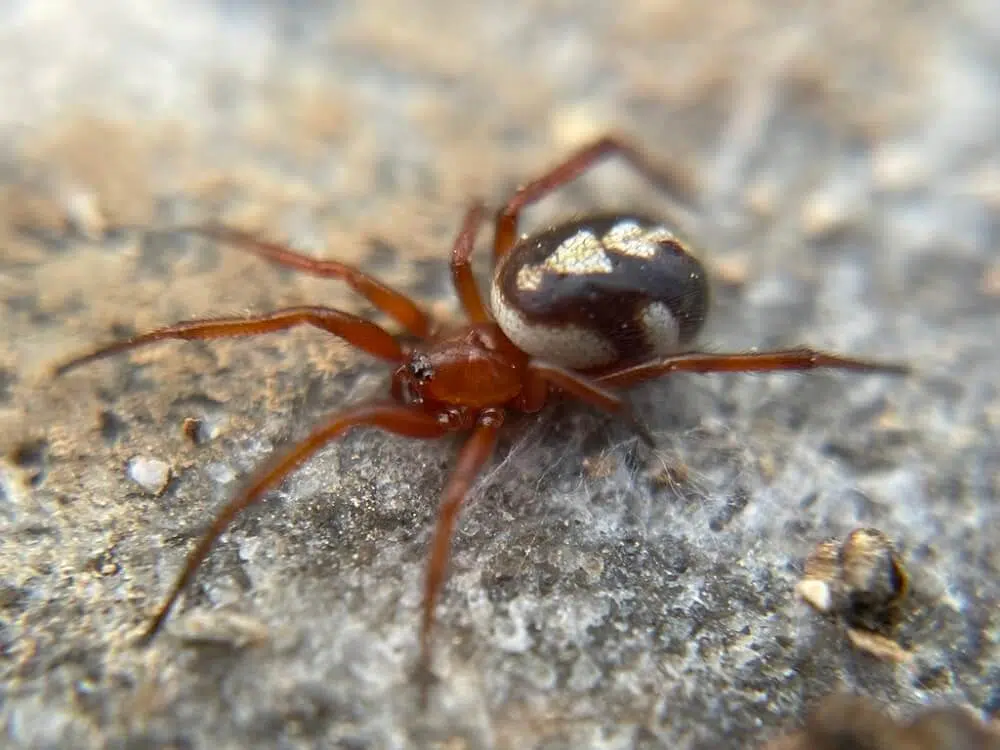
Scientific name: Asagena fulva
Common name: Red-and-white asagena
Red-and-white Asagenas are also part of the Theridiidae family. The species resembles Spotted Cobweavers.
This group of spiders is mostly red. The darker cephalothorax is red while the red abdomen is slightly brighter.
A bulbous abdomen is characteristic of most spiders of this wider category.
Like most Theridiidae spiders, Red-and-white Asagens have marked abdomens.
A central irregular shape white line and a bordering white line are seen on the abdomen.
The species is common in Southern states, especially on arid terrains.
These spiders are also found in Mexico.
31. Emerton’s Bitubercled Cobweaver
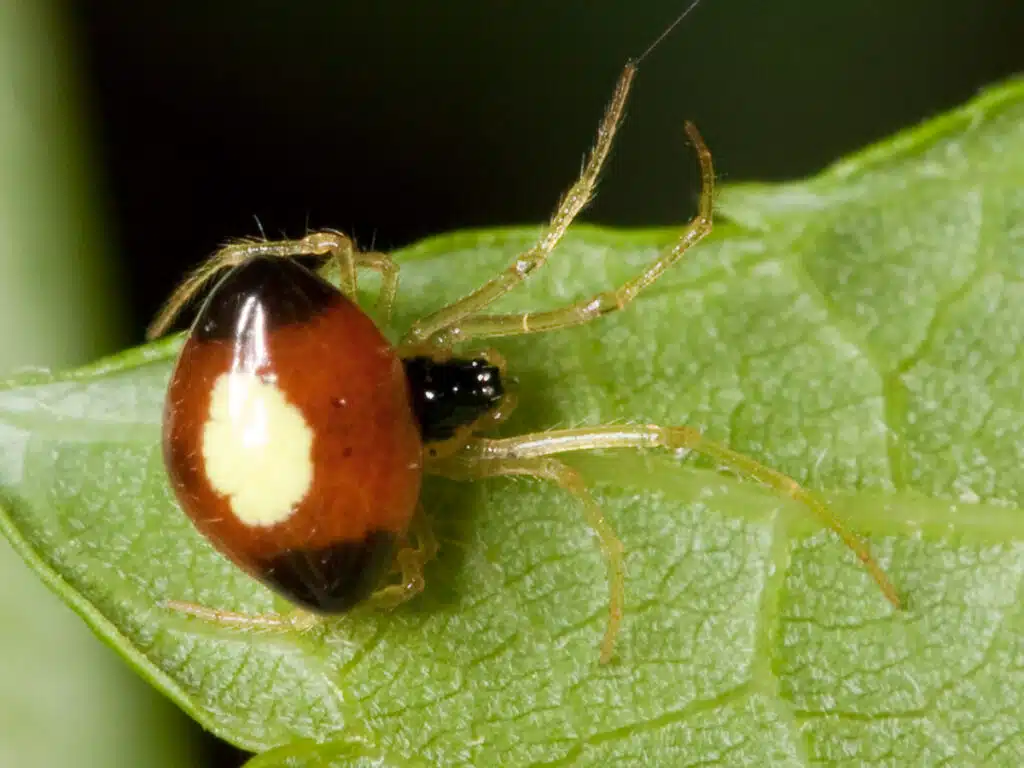
Scientific name: Theridula emertoni
Common name: Emerton’s bitubercled cobweaver
This is one of the smallest red spiders in the world. Adult females can be as small as 1.7mm while males can measure 1.6mm.
The dome-shaped abdomen is the largest part of the body of the species. It has a faded red color presenting 2 lateral black marks and a central yellow spot.
These spiders have pale yellow or pale orange legs.
The cephalothorax of the species is mostly black.
Common in woodlands, parks, and gardens, these spiders can often be seen on leaves or plant stems.
Male spiders of this genus are known for having different coloring.
Male Emerton’s Bitubercled Cobweavers have a black cephalothorax, a black abdomen, and one or multiple yellow marks on the abdomen.
32. Cornfield Bolas Spider
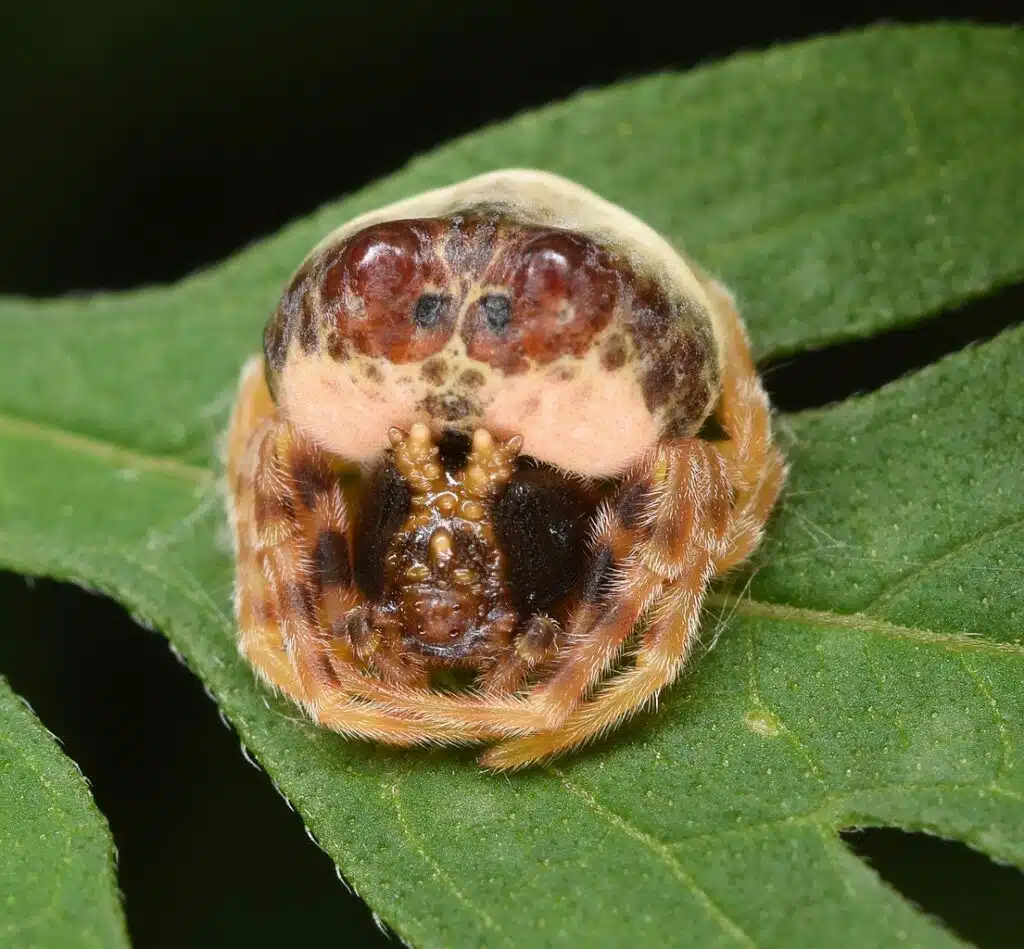
Scientific name: Mastophora hutchinsoni
Common name: Cornfield bolas spider, American bolas spider
The Cornfield Bolas Spider is one of the red spiders with a very specific diet.
Females have a dark brown body color but males have a red to blue coloring.
Spiders of this genus are nocturnal and avid hunters of moths. They have poor vision and might struggle to find moths solely relying on their eyes.
This is why Cornfield Bolas spiders use 2 atypical techniques to find prey.
They release a chemical odor similar to the odor released by moths to attract them.
The hairs female Cornfield Bolas spiders have on their legs also help them find moths when they fly by detecting vibrations.